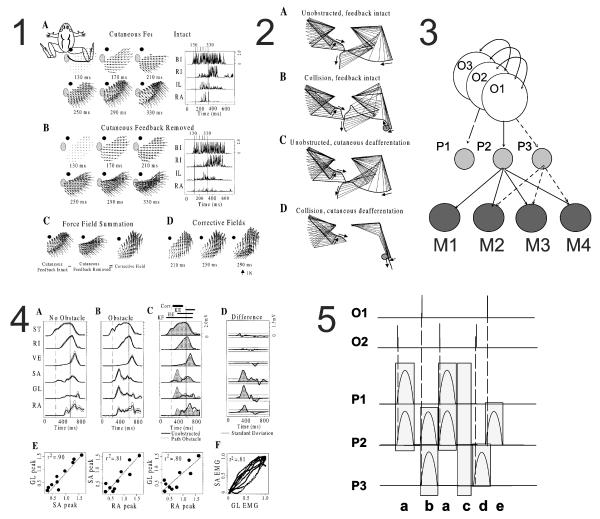Figure 2.
Synchronous burst synergies and force-field primitives in a spinal behavior. The wiping behavior can be examined in free kinematics (Panel 2 and 4) or measuring isometric force (Panel 1). The manipulations in free kinematics show cutaneous sensing of impact is required to trigger correction (compare Panel 2 C and D). This allows the isometric force generation to be compared with and without corrections (Panel 1 A and B). The correction is a scaled and similar force-field added into the force-fields generated unde isometric conditions for wiping (Panel 1 D). This is compatible with composition using force-field summation. The scheme suggested by this is shown in Panel 3. Rhythm generation systems (O1, O2, O3…) recruit circuits for primitives that project to motor pools for multiple muscles (e.g. P2 to M1, M2, M3, M4 pools). These provide balanced drive to the muscles generating balanced and predictable torque and force. The balanced drive in the correction is shown in Panel 4. The electromyograms are from free kinematics and real obstacle corrections. EMG changes in A and B are overlain in C and subtracted in D. In D a synchronous pulse is clear. In E the correlation of pulse peaks among the three muscles across multiple corrections are shown. In F the evolution of the pulses in two muscles is displayed. The behavior of the muscles in Panel 4 is fully compatible with a synchronous pulsed drive system like that shown in Panel 5. The motor pattern generated at spinal levels is organized as a sequence of co-active and phased pulses of synchronous drive (P1-P3) that are recruited in a hierarchical fashion by a rhythm generator system (O1,2). These can be recruited in combinations (a, b) or individually (d,e). This pattern can then be deconstructed back into component synchronous muscle-synergy pulses P1,P2,P3 and their combinations. The pattern generation scheme supporting this compositionality comprises rhythm generators that project to a pattern shaping system comprised of primitives as in panel 3. This matches schemes proposed independently by McCrea and Rybak, and by Cappelini, Ivanenko, Poppele Lacquaniti and colleagues. (Data in Panels 1, 2, 4 from Kargo and Giszter 2000b). Neurons that could support such a synchronous premotor drive in frogs have now been recorded (Hart and Giszter, accepted).

